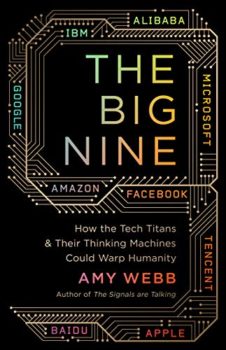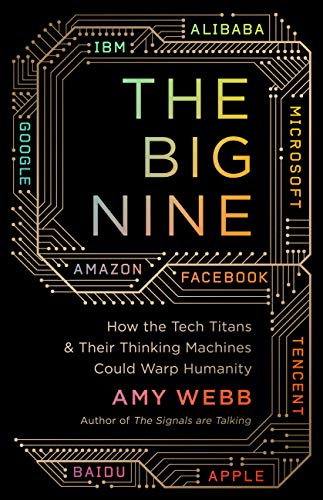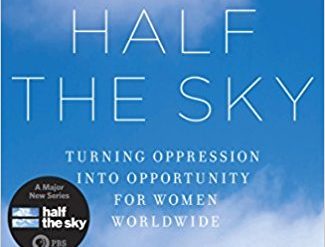
If you’re looking for an expert to confirm your fears about killer robots, the grey goo problem, or robots taking all our jobs, you’re in the wrong place. Amy Webb began her career as a reporter for the Wall Street Journal. She has become a widely respected futurist, author, and founder of the Future Today Institute in Philadelphia. Webb is also a professor of strategic foresight at New York University’s Stern School of Business and frequently advises corporate and government leaders. It would be hard to find a better-credentialed person to view what human society can expect from the future of artificial intelligence. That’s the subject of her superb new book about a future dominated by AI, The Big Nine.
Webb is tough, and highly critical at times, but her approach is well-balanced. There’s no hysteria or irrational exuberance in this book. “Fundamentally,” she writes, “I believe that AI is a positive force, one that will elevate the next generations of humankind and help us to achieve our most idealistic visions of the future.”
The Big Nine: How the Tech Titans and Their Thinking Machines Could Warp Humanity by Amy Webb (2019) 337 pages ★★★★★
A future dominated by AI
The Big Nine consists of three sections. In Part I, Webb explains what AI is all about and describes the role that the Big Nine have played in developing it. She also briefly sketches the history of artificial intelligence from the 17th century to the present. (It’s a fascinating treatment of the subject and reaches farther back into the past than other accounts I’ve read.) Part II includes three imaginative scenarios for how AI might play out over the next 50 years. In Part III, Webb introduces her prescription for action to stave off the worst of the problems that might arise from the shift from ANI (weak AI or artificial narrow intelligence) to AGI (strong AI or artificial general intelligence). And she makes clear that those problems may represent an existential threat to Western civilization as we know it today.
Artificial intelligence may upend the world balance of power and wealth
For nearly 2,000 years up until about 1800, China and India were the wealthiest societies on the planet. But the Industrial Revolution quickly changed that. By the end of the 19th century, both countries had deeply descended into poverty. And that trend only continued until Deng Xiaoping in 1978 and Manmohan Singh in 1991 set their nations firmly on the path to economic growth. Now, in Webb’s view, the advent of artificial intelligence may soon reverse the imbalance. China, already on the way to become the world’s dominant economic power in less than a decade, may soon achieve political and military hegemony as well—unless the leadership of the United States wakes up to the threat posed by AI. And if we in the US continue to ignore that threat, we might well find it increasingly difficult to compete with China. In a future dominated by AI, we’re likely to find that we’re captive to Chinese AI.
Why AI poses an economic, political, and military threat to the world
Webb’s arguments boil down to four essential points:
1. The Chinese government controls all artificial intelligence R&D in China
China’s three leading companies engaging in artificial intelligence research operate under the thumb of the country’s central government. (The companies are Baidu, Alibaba, and Tencent, and they’re all huge.) The three—Webb calls them the BAT—share all their data and technology with the central government. Beijing is free to put all that to use for social control and military development. Which, in fact, it’s doing in a very big way.
The Social Credit System
The implications of this marriage between government and the private sector in China are deeply troubling. One important indication of how this might play out lies in the Chinese Communist Party’s AI-powered Social Credit System. The system “was developed to engineer a problem-free society by ‘allow[ing] the trustworthy to roam everywhere under heaven while making it hard for the discredited to take a single step.’ To promote ‘trustworthiness,’ citizens are rated on a number of different data points, like heroic acts (points earned) or traffic tickets (points deducted).”
Shades of 1984 and Brave New World
There is nothing subtle about the Social Credit System. “Citizens are labeled and sorted into different brackets, ranging from A+++ to D, and their choices and ability to move around freely are dictated by their grade. . . Those with lower scores face hurdles applying for jobs, buying a home, or getting kids into schools. In some cities, high-scoring residents have their pictures on display. In other cities, such as Shandong, citizens who jaywalk have their faces publicly shared on digital billboards and sent automatically to Weibo, a popular social network.” It’s difficult to ignore how chillingly this system calls up analogies to 1984 and Brave New World.
2. China’s President has set out to use AI to make China the world’s leading power by 2030
Chinese President Xi Xinping has made AI the country’s top priority and is investing billions in making China the world’s leading power by 2030. Of course, the state’s vast resources are also directed toward building the Chinese military into the most powerful in the world. And China is ensnaring dozens of countries throughout Asia, Africa, and Latin America through unaffordable infrastructure loans.
But the country is also investing billions in AI, much of it to drain elite American and British universities and tech companies of their top talent. Meanwhile, Xi’s Belt and Road Initiative involves exporting the Social Credit System. And that will effectively add to the 1.4 billion Chinese whose lives will soon be controlled by Beijing as the people of China’s satellites are drawn into the system. It’s all part of the strategy to make China the new colonial power. But AI is the key to this strategy. And, Webb writes, “if AI is China’s space race, it’s currently positioned to win, and to win big.”
3. The Trump Administration is blind to the threat of the Chinese strategy
The US political leadership is blind to the implications of Xi Xinping’s strategy. Our federal government continues to cut back on AI funding when what is called for is a massive nationwide program comparable to the Manhattan and Apollo Projects. The Obama Administration took a tentative step in this direction. But President Trump has eliminated the program. And he has been systematically cutting back on science programs in general since 2017. Which is precisely the wrong approach to secure our future. “The US needs a cohesive national AI strategy backed by a reasonable budget,” Webb writes. And that budget must involve tens of billions of dollars.
4. America’s dominant AI companies are building their biases into AI
In the United States, six companies constitute what Webb terms the G-Mafia: Google, Amazon, Apple, Facebook, Microsoft, and IBM. (Together, these six and the BAT make up the Big Nine of the book’s title.) These six leading tech companies work competitively, largely ignore the social impact of their technology, and rush products to market too quickly in the interest of maximizing profit. They’re great at making gadgets that often make our lives easier. But they don’t think through in advance how those products might impact society. And they’re led largely by white men who fail to understand the importance of diversity and inclusion.
Like-minded people within small, insular groups
“The future of AI is being built by a relatively few like-minded people within small, insulated groups,” writes Webb. Like all insular groups, they develop strong shared biases. The upshot is that they’re building those biases into AI. And ethical considerations about the implementation of AI routinely take a back seat to profit and speed. (“Build it first and ask for forgiveness later.”) And here’s the crux of the matter: these like-minded people “are inculcating a culture in which women and certain minorities—like Black and Hispanic people—are excluded.” Not to mention the sexist assumptions that have been built into AI-driven software already in use.
“What’s not on the table, at the G-MAFIA or BAT,” insists Webb, “is optimizing for empathy. Take empathy out of the decision-making process, and you take away our humanity.”
There is no robot apocalypse in sight
“There won’t be a singular event when the technology blows up and goes bad,” Webb writes. “What we’re all about to experience is more like a gradual series of paper cuts.” Over the next 50 years, “we’re not heading toward a single catastrophe but rather the steady erosion of the humanity we take for granted today.” And the cumulative effect may be stifling. “There isn’t a facet of your personal or professional life that won’t be impacted by AI.”
In the future, Webb foresees, we might discover that our most personal choices are circumscribed by AI. For example, in her catastrophic scenario, we may find that “status is determined by ‘being our best selves,’ where ‘best’ got defined long ago by a relative few programmers who thought an organic ketogenic diet, midday yoga classes, and regular trips to the chiropractor were the keys to an optimized existence. If you don’t take a weekly infrared sauna, the AI system you’re tethered to will record noncompliance in your [personal data record].” This is far-fetched, of course, but the point is made.
Three scenarios for the development of AI
It’s no surprise that futurist Amy Webb would make extensive use of scenario planning in this book. Sketching out possible futures offers the most vivid way to demonstrate how different policy choices may play out in the future. And in Part II of The Big Nine, Webb does so adroitly. She presents three scenarios:
Optimistic scenario
At her most optimistic (and idealistic), Webb foresees the creation of GAIA (the Global Alliance on Intelligence Augmentation). GAIA represents a voluntary coalition of the federal government, major European nations, and the G-MAFIA. Together, they draw up standards and procedures to guide the continuing development of AI in a positive direction. This would involved “limit[ing] the rate of self-improvement [of AI], adding constraints into all AI systems to keep humans in the loop.” By its own choice, China opts not to join GAIA. The result is that the country finds its influence around the globe diminishing.
Pragmatic scenario
Toning down the idealism, Webb ventures onto a middle course in what she calls a pragmatic scenario. Nothing like GAIA has come into existence, and the US political leadership persists in ignoring the threat of China. That country now “dominates advanced tech industries, including robotics, new energies, genomics, and aviation.” Meanwhile, AI developers in the US continue to bring products to market, and to profitability, as quickly as possible. “Safety is an afterthought.” And a digital caste system emerges as automation eliminates waves of middle managers, including many in creative fields, as well as laborers and low-skill workers. Profits continue to shift upward to the top of the pay-scale and to investors. By 2069, American has become the “Digitally Occupied States of America.” China now controls most of Earth’s population. “Your transportation, bank, health care system, light switches, and refrigerators are all controllable by China.”
Catastrophic scenario
Perhaps it’s hard to imagine that Webb’s “catastrophic” scenario could be any worse than the pragmatic one. But she succeeds in chilling ways. But you’ll need to read the book to find out. I just don’t have the heart to summarize the impact here.
What is the solution?
Webb doesn’t advocate the approach recently popularized by Senator Elizabeth Warren—breaking up Google, Amazon, and Facebook through antitrust action. And she soundly rejects government regulation of AI. In general, the author’s approach is strongly pro-business. “The Big Nine aren’t the villains in this story. In fact, they are our best hope for the future.” However, Webb makes clear that steps must be taken now to ensure that this potential can be realized.
Create a global coalition of governments and tech companies
The creation of GAIA is at the top of Webb’s list. She also emphasizes that “the Big Nine should prioritize our human rights first and should not view us as resources to be mined for either profit of political gain.” It’s also critical in her view that “our personal data records should be interoperable and should be owned by us.” (Interoperability will prevent the creation of inescapable corporate systems that lock everyone into just one of a handful of AI-powered tech companies.) Webb lays out a prescription for action that consists of 15 items. And she makes the case for “reorienting” US attitudes and action toward China.
Government must learn what AI means—and fund basic research to advance it
The key to Webb’s proposed solution is that “people who work on budgets, those who write policy [in the American government] should demonstrate a working knowledge of AI and, ideally, should have technical expertise.” Because the crux of our problem currently is this: the Trump Administration has proposed funding for artificial intelligence research and development that consists of “appallingly low numbers that demonstrate a fundamental lack of understanding of what AI promises and truly requires. . . [I]f our government can’t or won’t fund basic research, then the G-MAFIA is stuck answering to Wall Street.” Which demands fast lab-to-market product launches and ever-increasing profits.
“AI demands courageous leadership now. We need our government to make difficult choices.”
Is Webb’s approach feasible?
It’s difficult to fault the logic Webb employs in The Big Nine. However, despite acknowledging the impact of climate change in her scenarios, I believe she significantly underplays how dramatic that might be. And what she describes as optimism is heavily laced with idealism. I fear that a great many of her recommendations for change will never be heeded. (Can you imagine Donald Trump acceding to the creation of anything like the GAIA Webb proposes?) Nonetheless, I hope every tech executive and investor in Silicon Valley will read this book. Webb has brought together between the covers of one short book a wealth of information—and informed speculation—about what lies ahead.
For related reading
In my most recent book, Hell on Earth: What we can learn from dystopian fiction, I used scenario planning to project possible futures based on a long list of catastrophic outcomes. You can read about the book here.
For more perspective on the impact of AI, see “‘Disastrous’ lack of diversity in AI industry perpetuates bias, study finds” (The Guardian, April 16, 2019).
You’ll find this book on The 40 best books of the decade from 2010-19.
This is also one of the books I’ve included in my posts, 5 best books about Silicon Valley, 10 best books about innovation, and Gaining a global perspective on the world around us.
You might also be interested in:
- 30 good books about artificial intelligence
- My 10 favorite books about business history
- Science explained in 10 excellent popular books
And you can always find all the latest books I’ve read and reviewed on the Home Page.


























